
Wine Culture and Information since 2002 - Volume 22
 Wine Culture and Information since 2002 - Volume 22 |
|
Comparing Valpolicella SuperioreValpolicella, one of the most renowned areas in Veneto, besides Amarone and Recioto gives other interesting and elegant red wines |
|
Corvina, Rondinella and Molinara: these are the indisputable queens in vineyards of Valpolicella, one of the most famous and successful areas of Veneto for the production of red wines. Valpolicella is generally identified for the production of Amarone and Recioto - two magnificent wines internationally renowned - nevertheless this area is also mother of other interesting red wines, all being recognized as Denominazione d'Origine Controllata wines (DOC, Denomination of Controlled Origin) by the Italian quality system. In particular Valpolicella Superiore and Valpolicella Ripasso, two wines which, for their quality and characteristics, are frequently considered as “lesser brothers” of Amarone. It is not in fact rare to find Valpolicella Superiore wines having consistency and structure almost reaching the levels of the celebrated Amarone, a result which has been obtained thanks to technological progress and, above all, to the adoption of quality viticultural and wine making techniques. Just like Amarone and Recioto, Valpolicella Superiore is mainly produced with Corvina, Rondinella and Molinara grapes, to which can be added Corvinone, Dindarella, Forselina, Negrara and Oseleta, as well as other grapes whose presence is pretty marginal in Valpolicella. Of these grapes, Corvina certainly is the one playing the main role, however - in recent times - also Corvinone is progressively playing an important role in wines of Valpolicella at the expense of the other two “classical” varieties Rondinella and, in particular, Molinara. Corvina is a medium-late ripening variety, of good strength, main responsible of the structure and body of red wines in this area. Its origin are not known, despite the first documents mentioning this grape are dated back to the beginning of 1800s, it is believed its presence in Valpolicella is dated back to remote times. Also the origins of Corvinone are not known and it was once considered a clone of Corvina, however recent genetic researches have found out they are two different varieties.
|
|
According to the production disciplinary, Valpolicella Superiore is characterized by an alcohol by volume of 12% and a lower acidity than “base” style, qualities making this wine rounder and smooth. Moreover, production disciplinary of Valpolicella Superiore requires at least one year of aging before being commercialized. The aging of this wine is generally done in wood container. Producers generally prefer the use of the traditional cask, however for the aging of Valpolicella Superiore some producers use barrique as well and, in some cases, both wood containers are used. Despite the production disciplinary requires at least one year of aging, most of Valpolicella Superiore is usually aged for a longer time than the ones set by law, also as long as - in some cases - two years.
Our comparative tasting will focus on three Valpolicella Superiore wines produced with different grapes percentages and varieties, although all being fermented and aged in traditional casks. The first wine of our tasting is Ca' Rugate's Valpolicella Superiore Campo Lavei, made with Corvina, Corvinone and Rondinella, aged in cask for 10 months. The second wine is Tedeschi's Valpolicella Classico Superiore La Fabriseria, made with the same grapes of the previous wine to which is added Oseleta, aged in cask for 18 months. The last wine of our comparative tasting is Speri's Valpolicella Classico Superiore Vigneto Sant'Urbano, mainly produced with Corvina and - in lower quantity - Rondinella, Corvinone and Molinara, aged in cask for 18 months, just like the previous wine. The tasting will be done - as usual - in three ISO tasting glasses and the wines will be evaluated at the temperature of 18°C (65°F).
|
||||||||
|
The aspect of Valpolicella Superiore shows different characteristics, although most of the cases can be observed pretty intense colors and a moderate transparency. The main responsible of color in Valpolicella Superiore is Corvina, a variety having good coloring properties, however requiring quality viticultural principles with low yields for the production of wines having low transparency and deep and intense colors. In its youth - while keeping in mind according to the production disciplinary this wine must age for at least one year - Valpolicella Superiore shows an intense ruby red color and nuances of the same color, however this can also get evident garnet red hues. This will be the color, after some years of aging in bottle, to take the place of ruby red, and with time it will change into garnet red, qualities signaling in a red wine the development towards the peak of aging. Let's pour the three wines in glasses, keeping them close one to each other in order to allow a proper comparison of appearance qualities. Let's start appearance analysis from Ca' Rugate's Valpolicella Superiore Campo Lavei. By keeping the glass tilted over a white surface, we will observe the wine at the base where it will be noticed an intense ruby red color as well as a moderate transparency. Nuances, observed to the edge towards the opening of the glass, will show a garnet red color. Let's now proceed with the second wine: Tedeschi's Valpolicella Classico Superiore La Fabriseria. The color is intense and brilliant ruby red, with a lower transparency than the previous wine. Nuances, also in this case, show a garnet red color. The aspect of the third wine - Speri's Valpolicella Classico Superiore Vigneto Sant'Urbano - is not different from the previous wine. Also in this case can be observed an intense and brilliant ruby red color, moderate transparency and garnet red nuances.
|
|
Valpolicella Superiore expresses its olfactory profile with aromas of flowers and fruits to which are added tertiary qualities, result of the aging in cask. It will be aromas of blackberry and violet to mainly characterize Valpolicella Superiore, however we will also find aromas of plum and black cherry. Other fruit aromas found in Valpolicella Superiore include blueberry and cherry, whereas in flower aromas - besides violet - can be found rose and, marginally, cyclamen. Thanks to the aging in cask, as well as the aging in bottle, the aromatic profile of Valpolicella Superiore is also enriched by tertiary aromas, of which the most frequent one is vanilla as well as licorice, cinnamon, black pepper, mace, pink pepper, leather and chocolate. With time, fruit aromas will develop to equivalent jam aromas, aromas which can also be perceived soon after commercialization of the wine. Finally, in Valpolicella Superiore can be perceived balsamic aromas of menthol and eucalyptus. Let's start the olfactory analysis of our comparative tasting, made of two distinct phases: in the first one, done with the glass in vertical position and without swirling, will be evaluated opening aromas, that is the qualities identifying a wine, whereas the second phase is done after having swirled the glass while keeping it titled, operation which will allow the evaluation of all the remaining aromas. We will start from Ca' Rugate's Valpolicella Superiore Campo Lavei and, by keeping the glass in vertical position and without swirling, we will proceed with the first smell in order to evaluate opening aromas. From the glass will be perceived intense and clean aromas of black cherry, blackberry and plum, three qualities - in particular blackberry - frequent in Valpolicella Superiore. After having swirled the glass, we will keep it titled and we will do another smell therefore completing the profile with aromas of blueberry and violet, as well as complex aromas of vanilla, tobacco, licorice, cinnamon, chocolate and mace. It should be noticed the pleasing balsamic touch of menthol and a slight hint of black pepper. Let's now pass to the evaluation of the olfactory profile of the second wine of our comparative tasting: Tedeschi's Valpolicella Classico Superiore La Fabriseria. The opening aromas of this wine - evaluated without swirling the glass - is characterized by black cherry, plum and blackberry, not so different from the previous Valpolicella Superiore. After having swirled the glass, we will proceed with the second smell therefore completing the profile with the aromas of violet, blueberry, cocoa, vanilla, tobacco, black pepper and the pleasing balsamic touch of menthol. The evaluation of the opening of the third wine - Speri's Valpolicella Classico Superiore Vigneto Sant'Urbano - will allow the perception to the nose of the aromas of blackberry, black cherry and plum, intense and clean. After having swirled the glass, in order to oxygenate the wine and favoring the development of other aromas, it will be perceived aromas of blueberry, violet, raspberry, vanilla, chocolate, tobacco, licorice, mace and cinnamon, as well as the pleasing balsamic touch of menthol.
|
||||
|
For its characteristics - although it is a wine made with different wine making techniques while having the same grape varieties - Valpolicella Superiore has many qualities in common with the renowned Amarone. Frequently considered, together with “Ripasso”, as the lesser brother of the famous red wine from Veneto, Valpolicella Superiore sometimes has a pretty robust structure, result which is obtained, as usual, by adopting quality viticultural and wine making principles. The attack of Valpolicella Superiore is frequently characterized by an appreciable astringency and high alcohol - it is not rare to have values higher than 13.5% - and a perception of good body. The wine is balanced by a pleasing roundness, result both of the aging in cask as well as the qualities of grapes, with a pretty low acidity. The mouth has very good correspondence to the nose and can be generally found the identifying flavors of the opening, that is blackberry, plum and black cherry. The first wine of our comparative tasting we will evaluate is Ca' Rugate's Valpolicella Superiore Campo Lavei. The attack of this wine allows the appreciation of an evident astringency which is however balanced by alcohol. It should be noticed a low acidity in this wine and a pleasing roundness, as well as a good correspondence to the nose. The attack of the second wine - Tedeschi's Valpolicella Classico Superiore La Fabriseria - is characterized by an evident astringency, also in this case balanced by a high alcohol by volume, to which is also added a pleasing roundness. Also in this case, the correspondence to the nose is very good. Let's end the comparative tasting with the third wine: Speri's Valpolicella Classico Superiore Vigneto Sant'Urbano. Just like the previous wines, the attack is characterized by an evident astringency and a pretty high alcohol by volume, properly contributing to the balance of tannins. It will also be appreciated a pleasing roundness and a very good correspondence to the nose.
|
|
A quality which can be perceived in the mouth is the structure, which in all the three cases can be defined of good body, almost robust. The finish of Ca' Rugate's Valpolicella Superiore Campo Lavei is persistent leaving in the mouth intense and clean flavors of blackberry, black cherry and plum, flavors which can also be found to the nose and identifying Valpolicella Superiore. The finish of the second wine of our comparative tasting - Tedeschi's Valpolicella Classico Superiore La Fabriseria - is persistent, leaving in the mouth sensations similar to the previous wine and recalling black cherry, plum and blackberry. The finish of the third and last wine of the comparative tasting, Speri's Valpolicella Classico Superiore Vigneto Sant'Urbano, is persistent, expressing in the mouth intense and clean flavors of blackberry, plum and black cherry, also in this case, a characteristic of the wines in this area. Finally, it should be noticed the sensation of structure which can be perceived in the mouth after having swallowed the wine.
|
Wines of the Month |
|
|
|
Score legend Prices are to be considered as indicative. Prices may vary according to the country or the shop where wines are bought |
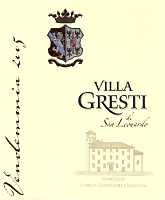
|
|
Villa Gresti 2005 |
|
| Tenuta San Leonardo (Trentino, Italy) | |
| Grapes: Merlot (90%), Carmenère (10%) | |
| Price: € 28.00 | Score: |
| Villa Gresti shows an intense ruby red color and nuances of garnet red, little transparency. The nose denotes intense, clean, pleasing, refined and elegant aromas that start with hints of black currant, black cherry and plum followed by aromas of blueberry, violet, vanilla, tobacco, chocolate, mace, bell pepper, eucalyptus and pink pepper. The mouth has good correspondence to the nose, a tannic attack and however balanced by alcohol, full body, intense flavors, pleasing roundness. The finish is persistent with flavors of black currant, black cherry and plum. A well made wine. Villa Gresti ages for 14 months in barrique followed by at least 12 months of aging in bottle. | |
| Food Match: Game, Roasted meat, Stewed and braised meat, Hard cheese | |
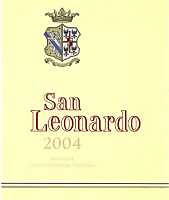
|
|
San Leonardo 2004 |
|
| Tenuta San Leonardo (Trentino, Italy) | |
| Grapes: Cabernet Sauvignon (60%), Cabernet Franc (30%), Merlot (10%) | |
| Price: € 45.00 | Score: |
| San Leonardo shows a brilliant ruby red color and nuances of ruby red, little transparency. The nose reveals intense, clean, pleasing, refined and elegant aromas which start with hints of black currant, black cherry and plum followed by aromas of violet, blueberry, vanilla, tobacco, bell pepper, raspberry, pink pepper, cocoa, cinnamon and eucalyptus. The mouth has excellent correspondence to the nose, a tannic attack and however balanced by alcohol, full body, intense flavors, pleasing roundness. The finish is very persistent with long flavors of black currant, black cherry and plum. A well made wine. San Leonardo ages for 24 months in barrique followed by 12 months of aging in bottle. | |
| Food Match: Game, Roasted meat, Stewed and braised meat, Hard cheese | |
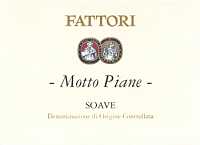
|
|
Soave Motto Piane 2008 |
|
| Fattori (Veneto, Italy) | |
| Grapes: Garganega | |
| Price: € 20.00 | Score: |
| Soave Motto Piane shows an intense golden yellow color and nuances of golden yellow, very transparent. The nose reveals intense, clean, pleasing and refined aromas that start with hints of apple, pear and peach followed by aromas of pineapple, citrus fruits, almond, plum, medlar, hawthorn and vanilla. The mouth has good correspondence to the nose, a crisp attack and however balanced by alcohol, good body, intense flavors, pleasing roundness. The finish is persistent with flavors of plum, peach and almond. Part of Soave Motto Piane referments and ages in cask. | |
| Food Match: Pasta and risotto with vegetables and crustaceans, Mushroom soups, Sauteed white meat, Sauteed fish | |
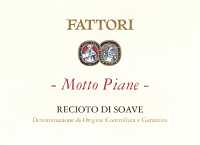
|
|
Recioto di Soave Motto Piane 2007 |
|
| Fattori (Veneto, Italy) | |
| Grapes: Garganega | |
| Price: € 25.00 - 500ml | Score: |
| Recioto di Soave Motto Piane shows a deep golden yellow color and nuances of golden yellow, transparent. The nose reveals intense, clean, pleasing and refined aromas which start with hints of raisin, dried apricot and almond followed by aromas of candied fruits, dried fig, honey, vanilla, quince jam, citrus fruit peel and nail polish. The mouth has good correspondence to the nose, a sweet and round attack, however balanced by alcohol, good body, intense flavors, agreeable. The finish is persistent with flavors of raisin, dried apricot, honey and almond. Recioto di Soave Motto Piane ages for 12 months in cask. | |
| Food Match: Fruit and cream tarts, Hard cheese | |

|
|
Recioto della Valpolicella Classico La Roggia 2005 |
|
| Speri (Veneto, Italy) | |
| Grapes: Corvina (70%), Rondinella (30%) | |
| Price: € 33.00 - 500ml | Score: |
| Recioto della Valpolicella Classico La Roggia shows an intense ruby red color and nuances of ruby red, little transparency. The nose reveals intense, clean, pleasing, refined and elegant aromas which starts with hints of blackberry, black cherry and plum followed by aromas of dried violet, blueberry, vanilla, tobacco, nail polish, pink pepper, cocoa, cinnamon and menthol. The mouth has good correspondence to the nose, a sweet and tannic attack, however balanced by alcohol, full body, intense flavors, pleasing roundness. The finish is persistent with flavors of blackberry, black cherry and plum. A well made wine. Recioto della Valpolicella Classico La Roggia ages for 18 months in barrique. | |
| Food Match: Fruit desserts, Fruit tarts, Chocolate tarts | |
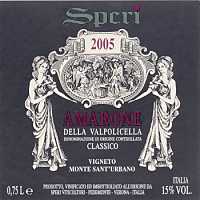
|
|
Amarone della Valpolicella Classico Vigneto Monte Sant'Urbano 2005 |
|
| Speri (Veneto, Italy) | |
| Grapes: Corvina (70%), Rondinella (25%), Corvinone (5%) | |
| Price: € 45.00 | Score: |
| Amarone della Valpolicella Classico Vigneto Monte Sant'Urbano shows an intense ruby red color and nuances of ruby red, little transparency. The nose reveals intense, clean, pleasing, refined and elegant aromas which start with hints of blackberry, black cherry and plum followed by aromas of violet, dried rose, vanilla, blueberry, tobacco, mace, menthol, chocolate, leather, black pepper and licorice. The mouth has good correspondence to the nose, a tannic attack and however balanced by alcohol, full body, intense flavors, pleasing roundness. The finish is very persistent with long flavors of blackberry, black cherry and plum. A well made wine. Amarone della Valpolicella Classico Vigneto Monte Sant'Urbano ages for 36 months in cask. | |
| Food Match: Game, Roasted meat, Stewed and braised meat, Hard cheese | |

|
|
Franciacorta Rosé Brut 2006 |
|
| Montedelma (Lombardy, Italy) | |
| Grapes: Chardonnay (55%), Pinot Noir (45%) | |
| Price: € 13.00 | Score: |
| Franciacorta Rosé Brut shows an intense pink salmon color and nuances of pink salmon, very transparent, fine and persistent perlage. The nose reveals intense, clean, pleasing and refined aromas which start with hints of cherry, raspberry and bread crust followed by aromas of strawberry, yeast, blueberry, pink grapefruit, tangerine and plum. The mouth has good correspondence to the nose, an effervescent and crisp attack, however balanced by alcohol, good body, intense flavors, pleasing roundness. The finish is persistent with flavors of cherry, raspberry and strawberry. Franciacorta Rosé Brut referments in the bottle on its lees for more than 24 months. | |
| Food Match: Roasted fish, Pasta with meat, Mushroom soups, Stuffed pasta | |

|
|
Franciacorta Satèn 2006 |
|
| Montedelma (Lombardy, Italy) | |
| Grapes: Chardonnay (90%), Pinot Blanc (10%) | |
| Price: € 14.50 | Score: |
| This Franciacorta Satèn shows a pale straw yellow color and nuances of greenish yellow, very transparent, fine and persistent perlage. The nose reveals intense, clean, pleasing and refined aromas which start with hints of pear, hazelnut and bread crust followed by aromas of yeast, banana, acacia, citrus fruits, hawthorn, apple and hints of mineral. The mouth has good correspondence to the nose, an effervescent and crisp attack, however balanced by alcohol, good body, intense flavors, agreeable. The finish is persistent with flavors of banana, apple and hazelnut. Franciacorta Satèn referments in bottle on its lees for 24 months. | |
| Food Match: Aperitifs, Fish and vegetable appetizers, Risotto with crustaceans | |

|
|
Garda Classico Chiaretto 2008 |
|
| Tenuta Roveglia (Lombardy, Italy) | |
| Grapes: Groppello (40%), Barbera (20%), Marzemino (20%), Sangiovese (20%) | |
| Price: € 7.00 | Score: |
| Garda Classico Chiaretto shows a brilliant pale pink color and nuances of pale pink, very transparent. The nose denotes intense, clean and pleasing aromas that start with hints of cherry, raspberry and banana followed by aromas of rose, blueberry and plum. The mouth has good correspondence to the nose, a crisp attack and however balanced by alcohol, good body, intense flavors, pleasing roundness. The finish is persistent with flavors of cherry, raspberry and blueberry. Garda Classico Chiaretto ages in steel tanks. | |
| Food Match: Meat appetizers, Pasta and risotto with meat and fish, Vegetable soups | |
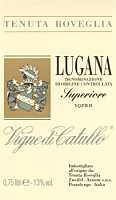
|
|
Lugana Superiore Vigne di Catullo 2007 |
|
| Tenuta Roveglia (Lombardy, Italy) | |
| Grapes: Trebbiano di Lugana | |
| Price: € 11.00 | Score: |
| Lugana Superiore Vigne di Catullo shows a pale straw yellow color and nuances of greenish yellow, very transparent. The nose denotes intense, clean, pleasing and refined aromas which start with hints of apple, plum and hawthorn followed by aromas of almond, pear, broom and peach. The mouth has good correspondence to the nose, a crisp attack and however balanced by alcohol, good body, intense flavors, agreeable. The finish is persistent with flavors of apple, plum and almond. Lugana Superiore Vigne di Catullo ages in steel tanks. | |
| Food Match: Pasta and risotto with fish and crustaceans, Sauteed fish, Fried fish | |
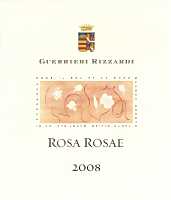
|
|
Rosa Rosae 2008 |
|
| Guerrieri Rizzardi (Veneto, Italy) | |
| Grapes: Corvina (65%), Rondinella (20%), Marcobona (15%) | |
| Price: € 9.50 | Score: |
| Rosa Rosae shows a brilliant cherry pink color and nuances of onion skin pink, transparent. The nose denotes intense, clean, pleasing and refined aromas that start with hints of cherry, raspberry and strawberry followed by aromas of peach, cyclamen, rose and plum. The mouth has good correspondence to the nose, a crisp attack and however balanced by alcohol, good body, intense flavors, agreeable. The finish is persistent with flavors of cherry, raspberry and strawberry. Rosa Rosae ages in steel and cement tanks. | |
| Food Match: Stuffed pasta, Roasted fish, Fish soups, Sauteed white meat | |

|
|
Amarone della Valpolicella Classico Villa Rizzardi 2004 |
|
| Guerrieri Rizzardi (Veneto, Italia) | |
| Grapes: Corvina (36%), Corvinone (24%), Rondinella (22%), Barbera (10%), Sangiovese (8%) | |
| Price: € 36.50 | Score: |
| Amarone della Valpolicella Classico Villa Rizzardi shows a brilliant ruby red color and nuances of garnet red, moderate transparency. The nose reveals intense, clean, pleasing and refined aromas that start with hints of blackberry, plum and violet followed by aromas of vanilla, black cherry, tobacco, chocolate, cinnamon, mace and menthol. The mouth has good correspondence to the nose, a tannic attack and however balanced by alcohol, full body, intense flavors, pleasing roundness. The finish is persistent with flavors of blackberry, plum and black cherry. Amarone della Valpolicella Classico Villa Rizzardi ages for 12 months in barrique, 24 months in cask and for 6 months in bottle. | |
| Food Match: Game, Roasted meat, Braised and stewed meat, Hard cheese | |
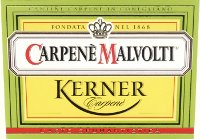
|
|
Kerner Brut |
|
| Carpenè Malvolti (Veneto, Italy) | |
| Grapes: Kerner | |
| Price: € 11.80 | Score: |
| Kerner Brut shows brilliant greenish yellow color and nuances of greenish yellow, very transparent, fine and persistent perlage. The nose denotes intense, clean and pleasing aromas which start with hints of peach, jasmine and pear followed by aromas of apple, pineapple and hints of mint. The mouth has good correspondence to the nose, an effervescent and crisp attack, however balanced by alcohol, good body, intense flavors. The finish is persistent with flavors of apple, peach and pear. Kerner Brut is made with the Charmat method. | |
| Food Match: Vegetable and crustacean appetizers, Vegetable flans, Eggs | |
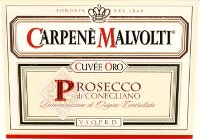
|
|
Prosecco di Conegliano Cuvée Oro |
|
| Carpenè Malvolti (Veneto, Italy) | |
| Grapes: Prosecco | |
| Price: € 8.50 | Score: |
| Prosecco di Conegliano Cuvée Oro shows a brilliant greenish yellow color and nuances of greenish yellow, very transparent, fine and persistent perlage. The nose denotes intense, clean and pleasing aromas that start with hints of pear, apple and wistaria followed by aromas of hawthorn, peach and broom. The mouth has good correspondence to the nose, an effervescent and crisp attack with pleasing sweetness, however balanced by alcohol, good body, intense flavors. The finish is persistent with flavors of peach, pear and apple. Prosecco di Conegliano Cuvée Oro referments in tanks. | |
| Food Match: Aperitifs, Semifreddo | |
|
||||||||
|
DiWineTaste Polls
|
| |||||||
Privacy Policy | |||||||


| Copyright © 2002-2024 Antonello Biancalana, DiWineTaste - All rights reserved |
| All rights reserved under international copyright conventions. No part of this publication and of this WEB site may be
reproduced or utilized in any form or by any means, electronic or mechanical, without permission in writing from DiWineTaste. |